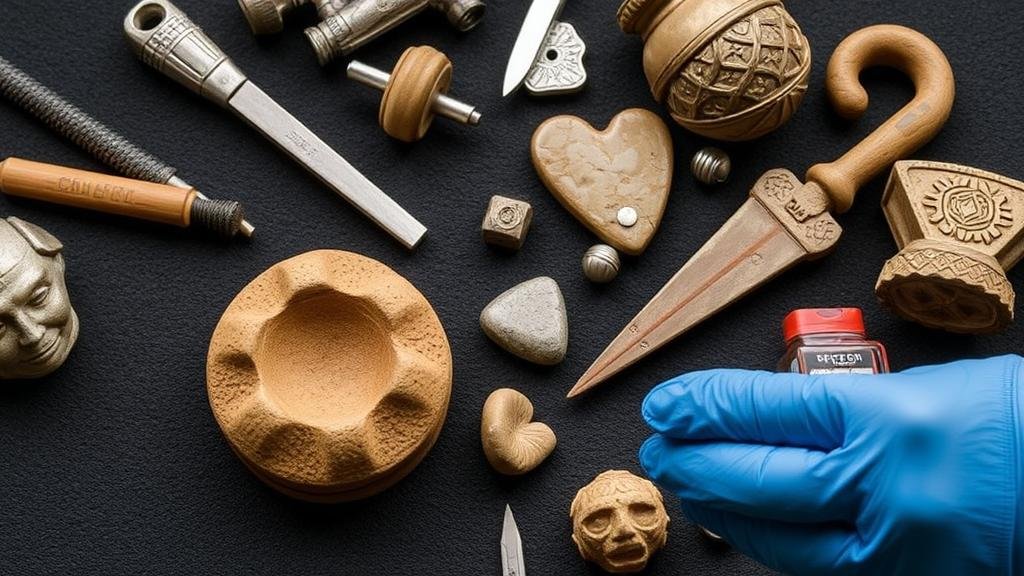Tools of the trade for identifying out-of-place artifacts and their origins.
Tools of the Trade for Identifying Out-of-Place Artifacts and Their Origins
Out-of-place artifacts (OOPArts) present a fascinating blend of archaeology, anthropology, and historical science. These items, which seem to be inconsistent with the known historical timeline or technological context of their discovery, pique the interest of researchers and enthusiasts alike. Proper identification and understanding of OOPArts require specific tools and methodologies. This article discusses essential tools and techniques used by professionals when engaging with OOPArts and their origins.
Understanding Out-of-Place Artifacts
OOPArts are objects that appear in a context that challenges conventional understanding of history or human progress. For example, the discovery of a metallic object within a coal seam, like the London Hammer found in 1934 in London, Texas, raises questions about its origin and the timeline of human technology. Such artifacts often evoke debates regarding ancient civilizations, their capabilities, and their interaction with other cultures.
Essential Tools for Artifact Identification
Researching OOPArts involves a variety of specialized tools that help experts assess and analyze these intriguing items. Here are some of the key tools that professionals utilize:
- Radiocarbon Dating
- Molecular Analysis Techniques
- Geological and Petrographic Analysis
- Forensic Science Tools
- Computational Modelling
Radiocarbon Dating
Radiocarbon dating is often the first tool employed when dating biological materials associated with OOPArts. This method measures the decay of carbon-14 isotopes, allowing researchers to estimate the age of organic artifacts. For example, charcoal found alongside ancient tools can be radiocarbon-dated to better understand the timeframe of the civilization that produced the artifacts.
Molecular Analysis Techniques
This category includes techniques such as DNA analysis and protein chromatography. For example, identifying the organic residues in pottery can offer insights into the diets and lifestyles of the ancient peoples that created them. In recent studies, molecular analysis of residues in the Neolithic pottery has provided vital information about food production and consumption over 6,000 years ago.
Geological and Petrographic Analysis
The geological context of an artifact can provide clues regarding its origin. By conducting petrographic analysis, scientists examine the mineral content and properties of the material used in the artifact. This technique has been pivotal in establishing the sources of stone tools and understanding trade networks. For example, the volcanic glass used in ancient tools can often be traced back to specific eruption sites, helping to map out ancient trade routes.
Forensic Science Tools
Forensic science approaches, such as imaging techniques, are increasingly used to analyze artifacts. Tools like high-resolution X-ray imaging and scanning electron microscopy (SEM) allow researchers to examine the composition and structure of materials at an atomic level. e techniques have been instrumental in the analysis of the Antikythera mechanism, an ancient Greek device that has baffled scholars, providing insights into its sophisticated design and function.
Computational Modelling
Computational modelling helps archaeologists simulate historical scenarios that contextualize OOPArts. This includes visualizing how ancient technologies may have been used or how artifacts could have been transported. These models have been used to propose that the Pyramids of Giza might have involved advanced logistics and labor organization that were ahead of their time.
Real-World Applications of Tools
The integration of various scientific tools in the examination of OOPArts has led to significant breakthroughs in our understanding of human history. r collaborative use encourages a multi-disciplinary approach in archaeology, anthropology, and natural sciences, bridging gaps in knowledge.
- Application of radiocarbon dating in establishing the timeline for the Serpent Mound in Ohio, which dates back to around 1000 CE.
- Deployment of molecular analysis techniques on residues from the Oldest known pottery in East Asia, revealing evidence of rice wine production over 8,000 years ago.
Actionable Takeaways
Identifying and analyzing out-of-place artifacts is a complex process that requires a variety of specialized tools. As technology evolves, so will the methodologies employed in archaeological science. Here are key takeaways for those interested in the study of OOPArts:
- Familiarize yourself with the latest dating and analytical techniques.
- Engage with interdisciplinary collaborative research to understand the broader context of OOPArts.
- Stay informed on recent discoveries and advancements in archaeological science.
The journey of exploring out-of-place artifacts is not only about the objects themselves but about the vast narratives they contribute to our understanding of human history.


